A Logical Golf Swing Concept relating to the techniques of the masters
This golf swing concept is the basis of a technique in which the arms, wrists and hands control the club through two distinct (lower and upper) parts in smooth co-ordination with body rotation around a vertical axis.
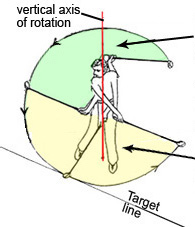 In the upper part the arms swing the club up and down (with wrist cocking on the inclined swing plane) in the backswing and downswing phases.
In the upper part the arms swing the club up and down (with wrist cocking on the inclined swing plane) in the backswing and downswing phases.There is a definite transition between the two parts wherein the wrist cocking action changes from being on the inclined swing plane in the upper part to vertical in the lower part.
In the lower part the arms move the club through the takeaway and sweep-thru-impact phases (with vertical wrist cocking) in unison with the body rotation.
Although the follow-thru can be an indicator as to the way in which the sweep-thru-impact was executed, it has no effect on the outcome of a golf shot. Therefore the follow-thru aspect is not included in this discussion.
Outcome is determined by the way in which the club is controlled during the sweep-thru-impact phase with the club and the wrist cocking action being contained within a vertical plane which is represented as being a virtual gate hinged to the vertical axis of rotation.
Although it is possible to perform a proper sweep-thru-impact from various combinations of ball address stance, takeaway, backswing and downswing actions; the performance is most effective and consistent when the set-up and takeaway are also contained within the virtual gate.
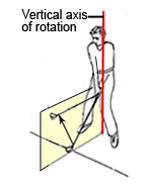 At ball address:The club is gripped with a standard overlapping or interlocking "vardon" formation.
At ball address:The club is gripped with a standard overlapping or interlocking "vardon" formation.That gripping method allows the wrists to cock uniformly when raising the club head vertically within the virtual gate with the club toe pointing straight up.
The club shaft extends straight out to the front from the vertical axis of rotation without setting the hands to incline the shaft towards the target.
In the takeaway: The arms turn with the body to bring the virtual gate back through 90 degrees around the vertical axis of rotation with wrist cocking contained within the virtual gate.
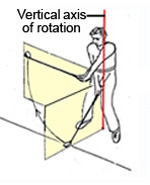 At the end of the takeaway the club shaft is horizontal and parallel to the target line with the toe of the club pointing straight up.
At the end of the takeaway the club shaft is horizontal and parallel to the target line with the toe of the club pointing straight up.The vertical raising of the club to horizontal by wrist cocking within the turning virtual gate causes the club head to move back and up on the inclined swing plane.
The arms and hands keep the virtual gate hinged to the vertical axis of rotation.
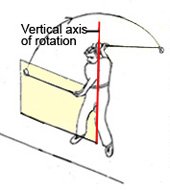 In the upper part: The arms swing up and back out of the virtual gate as the shoulders continue to turn bringing the club to above the outside of the right shoulder at the top of the backswing.
In the upper part: The arms swing up and back out of the virtual gate as the shoulders continue to turn bringing the club to above the outside of the right shoulder at the top of the backswing.The wrists retain their setting as it was at the end of the takeaway as the cocking continues.
The downswing is essentially the reverse of the backswing with the arms dropping straight down while firmly holding the wrist cocking setting and without any conscious forward rotation of the forearms.
In the downswing:The club is brought into the virtual gate with its toe pointing straight up as it was at the end of the takeaway.
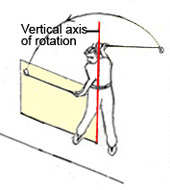
The wrists are then set for vertical uncocking within the virtual gate in the sweep-thru-impact.
In the sweep-thru-impact: The club head sweeps through on the inclined swing plane due to the combination of vertical uncocking of the wrists and rotation around the vertical axis with the hands passing through close to the lower body. The wrists uncock without conscious action as the right arm extends thru impact.
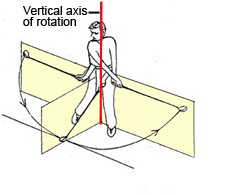 At impact: The club face will be positively square providing that:-
At impact: The club face will be positively square providing that:-The club remains contained within the virtual gate with the toe pointing straight up.
The wrist setting is retained such that uncocking is vertical within the virtual gate.
The virtual gate remains hinged to the vertical axis of rotation by the combined rotation of the arms and body.
Use the play/pause and slider bar buttons at the bottom of the above frame to manipulate the video action.
The foregoing describes the ideal form of this golf swing concept wherein the arms and hands are close to the lower body when sweeping thru impact in the lower part of the swing.
That underlying concept can be identified, not only in the techniques of present day elite golfers such as of Tiger Woods and Lee Westwood, but also in the great Ben Hogan’s swing from 50 odd years ago.
Although the techniques of some other top players, such as Fred Couples, Jim Furick and Sergio Garcia, do not conform to this concept entirely, particularly in the takeaway and upswing phases, they are essentially in conformity, where it matters, in the sweep thru impact phase.
With the intention of producing a more upright swing plane some players such as Fred Couples and Sergio Garcia lift their hands and the club into the upswing when the virtual gate has made only a half to threequarter turn into the takeaway. However they return to conformity to the concept at the start of the sweep thru impact.
In some other variations, such as in Jim Furick’s technique, the club head points directly forward in the takeaway but conforms to pointing straight up at the start of the sweep thru impact.
Furick also attempts to set up an upright swing plane by lifting his hands and the club straight up out of the virtual gate at the end of the takeaway to above his head. He then swings them back and down into a conforming start to the sweep-thru-impact.
The more any golf swing technique is in conformity with the ideal form of this concept the more consistently effective the performance.
To see how closely the swing techniques of some master golfers relate to A logical Golf Swing Concept go to:-The Tiger Woods Swing
The Lee Westwood Swing
The Fred Couples Swing
The Jim Furick Swing
The Sergio Garcia Swing
Or
Go to A New Insight into the Golf Swing